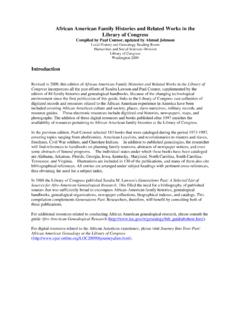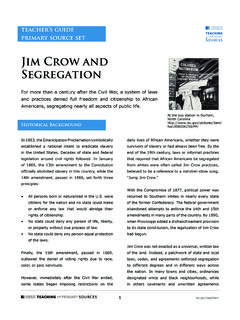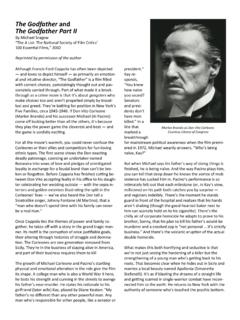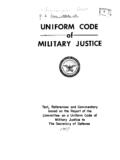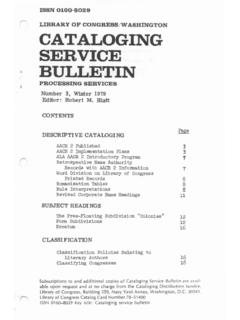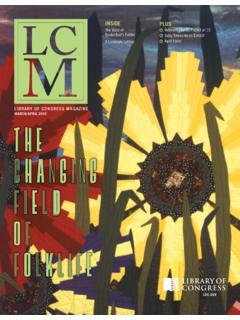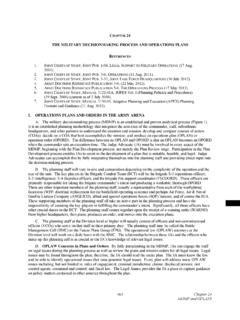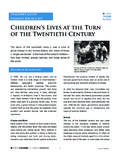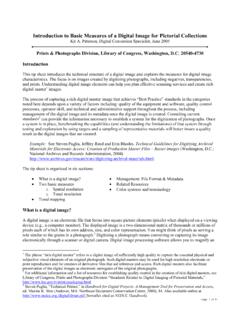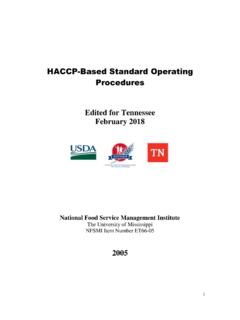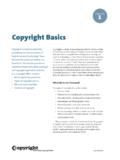Transcription of Library of Congress New Employee Orientation Guide
1 Library of Congress New Employee Orientation Guide Table of Contents About the Library of CongressOrganizational StructureService UnitsUsing Your Telephone and Voice MailFacilities InformationBuilding Entry and Exit ProceduresMaps: Library of Congress CampusEmergency InstructionsEmployee ServicesCredit UnionHealth Services OfficeEmployee Assistance Program (EAP)Interpretive ServicesDisability AccommodationsChildcare CenterBook BorrowingTravel ServiceSales ShopParking ProgramTransit SubsidyFood ServicesEmployee Performance and DevelopmentRequired TrainingLOC SkillPortOnline Learning CenterCareer DevelopmentSupervisor DevelopmentLeadership DevelopmentWorkforce Performance ManagementEmployee OrganizationsLabor Unions (Bargaining Units) Employee Associations and ClubsNeighborhood ServicesUseful Contact InformationAcronyms and Abbreviations LOC Staff Intranet (Website).
2 1 About the Library of Congress The Library of Congress is the nation s oldest federal cultural institution and serves as the research arm of Congress . It is also the largest Library in the world, with millions of items in its vast collections. The Library s mission is to support the Congress in fulfilling its constitutional duties and to further the progress of knowledge and creativity for the benefit of the American people. Organizational Structure The Library is comprised of seven Service Units (SUs), which work together to enact the mission of the Library : to support the Congress in fulfilling its Constitutional duties and to further the progress of knowledge and creativity for the benefit of the American people.
3 Service Units Office of the Librarian (LIBN) sets policy, directs, and supports programs and activities to accomplish the Library s mission. It is the administrative branch of the Library and has overall management responsibility for the Library . Included within this office are the Librarian of Congress , Deputy Librarian, Congressional Relations Office, Development Office, Office of Communications, Office of the General Counsel, Office of Special Events and Public Programs, Office of the Chief Financial Officer, and the Office of Contracts and Grants Management Congressional Research Service (CRS) analysts and legislative attorneys work directly with Congress on a daily basis to help the Congress identify, analyze, and formulate legislative proposals.
4 CRS provides Congress with authoritative, confidential, objective research and analysis on all legislatively relevant issues. Congress first established the Legislative Reference Service as a division of the Library in 1914 and, with the enactment of the Legislative Reorganization Act of 1970, expanded its mission and renamed it the Congressional Research Service. CRS is organized into five interdisciplinary research divisions: American Law; Domestic Social Policy; Foreign Affairs, Defense and Trade; Government and Finance; and Resources, Science and Industry. Copyright Office (COP) is the office of public record for copyright registration and deposit of copyright materials.
5 The office was designed to carry out a provision in the Constitution found in Article 1, Section 8: To promote the progress of science and useful arts, by securing for limited times to authors and inventors the exclusive right to their respective writings and discoveries. The office processes claims for copyright registration, documents for recordation, and works deposited under the mandatory deposit provisions of the law. It creates public records of these actions and provides copies of deposited works for the Library s collections. Since 1870, copyright deposits have been a primary source of collections materials for the Library , especially works by American authors.
6 The Copyright Office also plays a leadership role in addressing the increasingly important and complex copyright issues arising from the expanding use of digital technology in creative works. 2 Law Library of Congress (LLC) was created by an Act of Congress in 1832, and today houses the world s largest and most complete collections of legal materials in the world. Through its staff of attorneys, librarians, and other research, reference, and information management professionals, the Law Library supports the legislative work on the United States Congress , while providing research and reference support to other branches of the government, the bar and the general public.
7 The Law Library was a catalyst in creating and maintaining the Global Legal Information Network (GLIN), a global consortium of nations, including the United States, which works together to provide access to authoritative laws, statutes, regulations and other legal materials in their original language. Library Services (LS) includes five directorates. Its employees comprise more than half of the Library s staff. LS performs conventional Library functions, such as acquisitions, classification, cataloging, reference services, and preservation of the collections. It also administers numerous unique programs, including the National Film Preservation Board, the Cataloging Distribution Service, the Veterans History Project, and the National Library Service for the Blind and Physically Handicapped.
8 LS is responsible for the Library s general and special collections and serves the public through reading rooms that specialize in materials organized by world geographic region, subject matter, or format. Office of Strategic Initiatives (OSI) oversees Library -wide digital initiatives and leads the National Digital Information Infrastructure and Preservation Program to build a preservation network and infrastructure for the nation s important digital cultural and historical assets. OSI also oversees the National Digital Library , which makes available more than 22 million primary sources on the Library s website. Its Educational Outreach initiative is making these primary sources useful to teachers and their students nationwide.
9 OSI also includes Information Technology Services, which supports the technology needs of the entire Library by providing a flexible, sustainable and secure information technology environment. Office of Support Operations (OSO) supports the activities of the other Service Units and assists in meeting the needs of Library customers and employees. OSO is comprised of the following five functional divisions: Human Resources Services (HRS) helps cultivate, develop, and manage the Library s workforce through such functions as staffing and position classification, pay and benefits administration, Employee assistance, retirement counseling, training and development guidance, performance management, labor relations counseling, and Employee -management relations counseling.
10 Integrated Support Services (ISS) performs infrastructure support functions such as facility maintenance, Employee wellness care, office systems, and safety services that facilitate the Library s day-to-day conduct of business. Office of Security and Emergency Preparedness (OSEP) provides for and maintains the physical security of Library staff and visitors, safeguards Library facilities and assets, oversees personnel security, and manages the Library s Emergency Preparedness Program. 3 Office of Opportunity, Inclusiveness and Compliance (OIC) promotes fairness by providing Equal Employment Opportunity (EEO) services and advising the Library on diversity management programs, instituting measures to gauge the success of diversity management, and initiating analytic reviews to identify trends and proactively address issues for successful diversity management.
